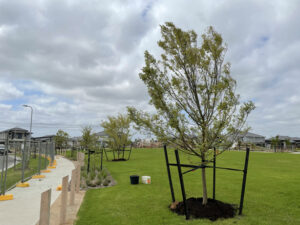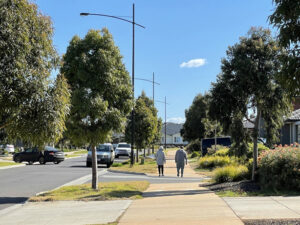Ideas for improving tree outcomes in new development areas
By Jason Summers
Creating treescapes can be impactful and improve the look and feel of a destination. To achieve high quality outcomes, it takes a lot of planning and appropriate species selection that is relevant to the location and local environmental conditions. Well-grown trees should be of an appropriate size to the proposed site and a maintenance program needs to be implemented. Trees should be planted correctly into well-prepared soils that are high in organic matter and biological life to help them flourish. Using organic sources of nutrients and biology enhances tree growth and survivability. Careful thought is required to ensure the look and feel, that we ultimately want, is achieved.
We can establish many different trees in new development areas with appropriate care and consideration. Designers need to think about how the site will look in 20-50 years to get it right. We then need to modify the environment and manage the trees to achieve this outcome, not simply tick a box to show we planted a tree to create a place where people want to stay, live and relax, but where people want to live, and are willing to pay for this outcome.
A few developers are certainly a lot closer to achieving this than in the past, but there are still many things we can do to achieve even better outcomes and make an estate or development stand out. Great entrance landscape statements, amazing parks, free private landscaping when you buy a block, and great tree-lined streetscapes are some of the things we can do. There are some risks we may need to take, and maybe we have some fails, but without risks there are no rewards.
Perhaps we need to offer council longer periods (other than the usual two-year maintenance period) to establish some of the tree species not found on their approved lists. We could create some unique forest parks or cool parks for retreating to during heatwaves. Council tree lists are restrictive and often based on poor experiences of past efforts. We need to increase diversity of species and families and push the envelope.
Soils
The chemical, physical and biological components of a soil need to be understood. This is the space where we can do the most to improve tree outcomes as currently it is never really considered. Understanding the nature, structure and biology of the soil, and not just nutrients, is the key. Getting different soil tests done, that measure the levels of bacteria and fungi, or their absence or presence in the soil, will assist this process and then we can make changes to improve the soil and the subsequent growth of trees. Adding organic matter, avoiding compaction and ensuring adequate drainage are all steps we can take to improve tree and landscape outcomes. A plan needs to be developed to manage the topsoil onsite, whilst normal subdivisional work occurs to ensure we do not damage soil and unnecessarily impact future tree growth. We need to understand and manage our soils on a scientific basis.

Trees
Species selection for different locations is vital and often not well thought out. Ensure trees have adequate above and below ground space to flourish, not just survive. Planting high quality tree stock of an appropriate size to ensure impact and good survival rates is achieved. Follow up post planting with good solid horticultural management will give trees every chance of survival. Larger sized stock may be planted however maintenance periods will need to be extended to ensure successful establishment.
Design
Select appropriately scaled trees for entrance plantings, major roads, residential streets, parks and sports fields. Use trees for shade near playgrounds, and along paths and boundaries of sporting fields to provide shade and shelter to spectators and visitors. Car parks should be designed with WSUD (Water Sensitive Urban Design). Passive irrigation and the use of bioswales gives trees access to water, and helps promote growth and the subsequent cooling effect and shade they provide.
Staging
Consideration needs to be given in the staging of the estate. Newly constructed houses can provide some wind relief to trees. To create an initial presence and set the scene for the rest of the estate, the sales and display area, and entrance to the estate need to be done to the highest standards. Trees on the development fronts, at the edges of the development area and adjacent to undeveloped open areas, are often difficult to establish due to lack of protection and will suffer most. They may require more maintenance to get them growing well. Consideration should be given to the later stages by delaying the planting during the house construction phase. This will help avoid inevitable damage caused by builders and the need to protect the planting, as the policing of builders can be challenging.

Installation
Trees on many estates are planted too deep with local soil piled on top of the root ball and as such the trees do not perform well. It is important to make sure your landscape contractors have qualified horticulturists or arborists in their teams to supervise and ensure quality planting outcomes. Some developers employ independent supervision of the procurement and installation, and even the maintenance process, to ensure quality outcomes.
Putting additives into soil can assist with higher success rates of trees, with many products available on the market. One thing often not thought of is the introduction of soil biology into the tree planting area. Using worm castings is one option that can assist with this process and helps improve soil performance, as is the blending of high quality compost with the site soil. A small increase in soil organic matter can increase soil water holding capacity.
Thought should be given to using stakes to protect a tree from builders and people delivering materials to building sites. Using perishable tree ties made from hessian ensures the ties don’t end up growing into the trees if not removed in time.

Establishment maintenance
The establishment maintenance period for trees is vitally important. Trees should be regularly monitored for drought stress, pests and diseases, weeds, fertilising and lack of mulch. Management of stakes and ties, including timely removal when required, is also important. Some trees will be damaged by builders, residents, etc., and, if required, will need to be replaced, so it is best to plant in autumn, winter or spring, and not in the heat of summer to give the trees the best chance of survival.
Watering regularly based on the root ball installation size is one of the easiest and most important tasks to establish trees. Keeping trees well mulched and keeping weeds and grass out of the tree berm also helps.
Some eucalypt species get attacked by lerps and other insects and may require treatment during the maintenance period. Some years can be drier than others and watering programs should be flexible so they can be increased or decreased based on locally measured actual rainfall figures. A weather station should be installed on-site to provide data-driven management and care of the trees.
Hand over to council
Council will want to accept healthy, vigorously growing trees that are self-supporting, formatively pruned for clearance and sightlines, free from pests and disease, and that are visually pleasing to the eye and uniform in size and stature. The well cared for trees should create a sense of place and improve the area over time.
Jason Summers
Remarkable Trees
M: 0400861703
E: jason@remarkabletrees.com
Main image: Playspaces that are well planted with trees offer nature play in mini forests (images supplied by Remarkable Trees)

